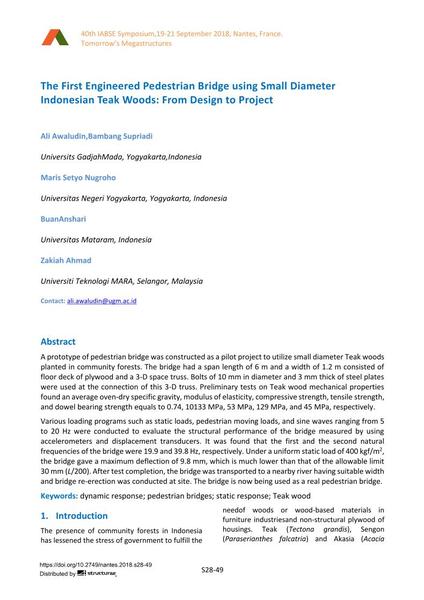The First Engineered Pedestrian Bridge using Small Diameter Indonesian Teak Woods: From Design to Project

|
|
|||||||||||
Détails bibliographiques
| Auteur(s): |
Ali Awaludin
(Universits GadjahMada, Yogyakarta,Indonesia)
Bambang Supriadi (Universits GadjahMada, Yogyakarta,Indonesia) Maris Setyo Nugroho (Universitas Negeri Yogyakarta, Yogyakarta, Indonesia) BuanAnshari (Universitas Mataram, Indonesia) Zakiah Ahmad (Universiti Teknologi MARA, Selangor, Malaysia) |
||||
|---|---|---|---|---|---|
| Médium: | papier de conférence | ||||
| Langue(s): | anglais | ||||
| Conférence: | IABSE Symposium: Tomorrow’s Megastructures, Nantes, France, 19-21 September 2018 | ||||
| Publié dans: | IABSE Symposium Nantes 2018 | ||||
|
|||||
| Page(s): | S28-49 | ||||
| Nombre total de pages (du PDF): | 8 | ||||
| DOI: | 10.2749/nantes.2018.s28-49 | ||||
| Abstrait: |
A prototype of pedestrian bridge was constructed as a pilot project to utilize small diameter Teak woods planted in community forests. The bridge had a span length of 6 m and a width of 1.2 m consisted of floor deck of plywood and a 3-D space truss. Bolts of 10 mm in diameter and 3 mm thick of steel plates were used at the connection of this 3-D truss. Preliminary tests on Teak wood mechanical properties found an average oven-dry specific gravity, modulus of elasticity, compressive strength, tensile strength, and dowel bearing strength equals to 0.74, 10133 MPa, 53 MPa, 129 MPa, and 45 MPa, respectively. Various loading programs such as static loads, pedestrian moving loads, and sine waves ranging from 5 to 20 Hz were conducted to evaluate the structural performance of the bridge measured by using accelerometers and displacement transducers. It was found that the first and the second natural frequencies of the bridge were 19.9 and 39.8 Hz, respectively. Under a uniform static load of 400 kgf/m², the bridge gave a maximum deflection of 9.8 mm, which is much lower than that of the allowable limit 30 mm (L/200). After test completion, the bridge was transported to a nearby river having suitable width and bridge re-erection was conducted at site. The bridge is now being used as a real pedestrian bridge. |
||||
| Mots-clé: |
passerelles piétonnnes
|
||||
